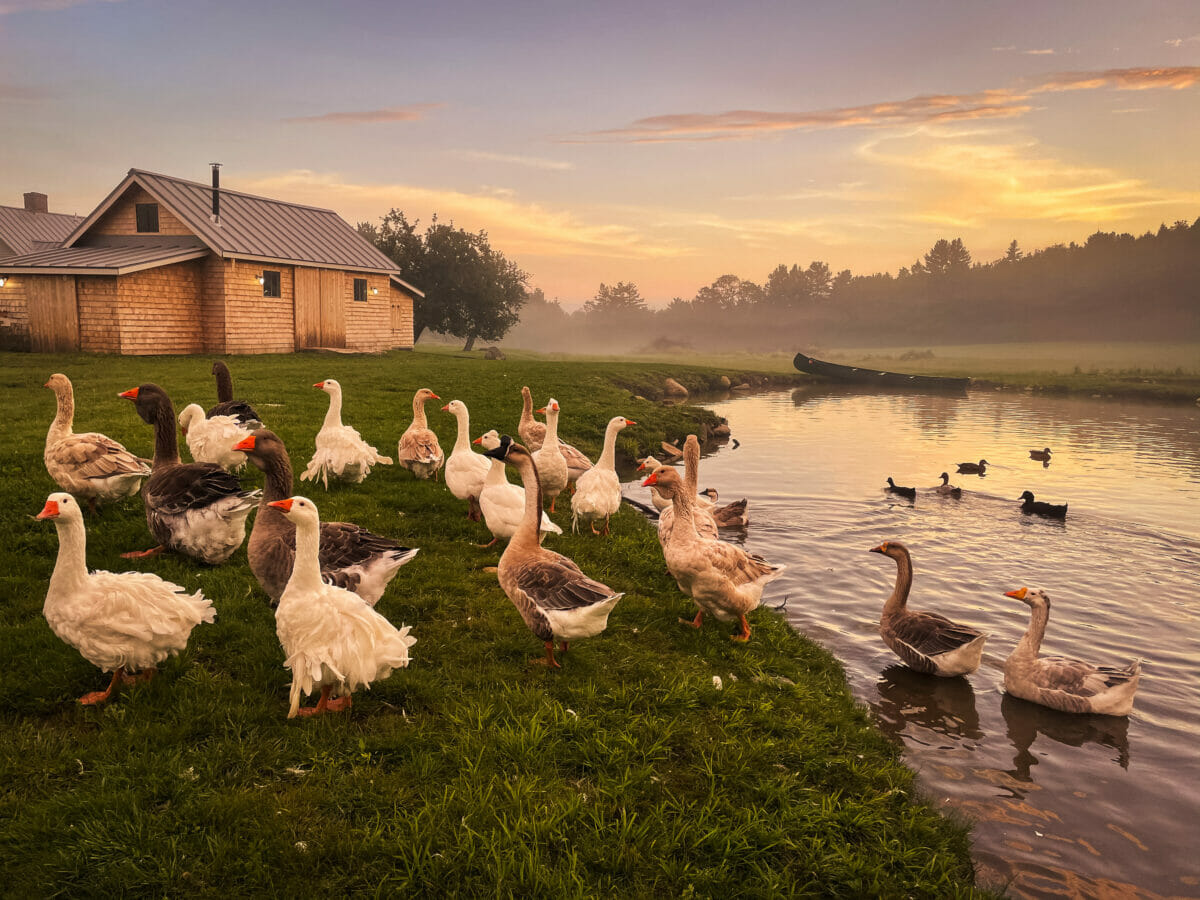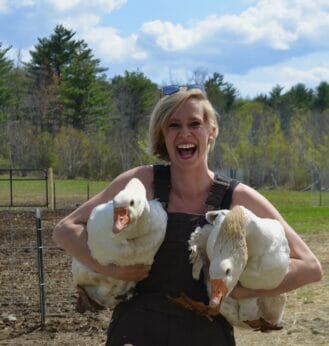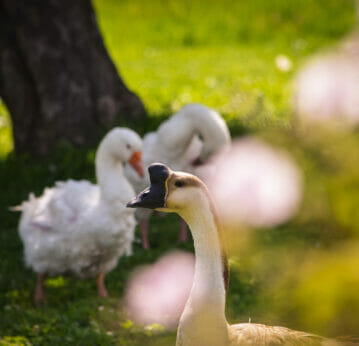I Was ‘The Goose Lady.’ Then Avian Flu Came For My Flock
Love and experience were not enough to save my birds from the highly contagious virus.
I Was ‘The Goose Lady.’ Then Avian Flu Came For My Flock
Love and experience were not enough to save my birds from the highly contagious virus.

Kirsten Lie-Nielsen raised a flock of nearly a hundred geese, chickens, guineas and ducks.by Kirsten Lie-Nielsen
The first bird was on the chicken coop floor, stiff and lifeless, when I came out for morning chores. As she was an elderly hen, my first thought was that age had caught up to her. But I felt a sinking worry, wondering if this was the beginning of the end.
No other birds seemed ill, but the next morning, two guinea fowl lay dead on the floor, their heads puffy and eyelids swollen shut. On the third day, a duck would not stop sneezing.
That third day, I called the Maine State Veterinarian to inquire what we should do if we thought we had High Pathogenic Avian Influenza (HPAI) in our flock. I knew that avian flu was killing flocks of commercial poultry—the outbreak has affected more than 58 million poultry birds in the U.S. at last count—and had read about protecting my birds from the spread of the virus. But I had no idea what steps to take if I was afraid my flock had HPAI.
Symptoms of HPAI include sudden deaths, sneezing and swollen heads.
The State Veterinarian informed me that it would send a representative to test our flock. If the test was negative, nothing would happen to our birds. If it was positive, our entire flock would be euthanized to help prevent the disease from spreading. It took a few days for the test to process, and then I got the phone call.
“I am afraid it is positive,” said Rachael Fiske, assistant state veterinarian in Maine.
The next day, officials arrived to euthanize our flock. Our birds were confined to their coop. The officials would capture them and put them in a confined box where carbon monoxide was applied, resulting in a quick and painless death. While they worked carefully to ensure the birds were not stressed, I could tell from the anxious honking of the flock that they understood the situation. The carcasses were then bagged in plastic and taken for secure disposal by the state.

Our first poultry arrived in a peeping box at the post office in 2013. We had ordered five chicks and two goslings.
The goslings imprinted on us, and all summer they followed us and settled in our laps when we sat down. My family had kept chickens when I was a kid, but geese were a new experience for me and I spent hours searching the internet for details on their care. As I fell in love with these birds, I realized there was very little information on keeping them—my best research being an out-of-print book that I had to get through an interlibrary loan. So, I started jotting down notes and making records of their care.
By 2016, when we moved to Liberty, Maine, we had a flock of more than 20 geese (and an additional 30 or so chickens and ducks), and my first book, The Modern Homesteader’s Guide to Keeping Geese, was headed to the publisher. I had become The Goose Lady.
Because goslings imprint easily, most of the geese in our flock saw me as “mother goose” and our bonds were strong, with birds running to my side when I stepped out of the house.
For years, we kept our geese and ducks happy with water troughs and buckets, but in 2021, we dug out a farm pond for the birds. They took to it instantly, swimming, bathing and splashing all day in the new open waters—as did passing wild ducks.
As news of avian flu began to bubble in the winter of 2021-22, commercial flocks in the Midwest seemed the most affected. However, some speculate it is small farms and homesteads that have led to the proliferation of HPAI because free-ranging birds interact more with wild birds. The rise in popularity of backyard poultry in recent years means even more intermingling.
In February 2022, a warm winter kept the pond waters open, and flocks of hundreds of migrating ducks used our farm as a stopover on their migrations north.
Information on HPAI suggested quarantining domestic birds: no interacting with wild flocks, shut your poultry in their coops indefinitely. I considered this, but our flock of geese was at the height of their mating season, fighting and setting their pecking orders for the year, and birds would be injured in an enclosed space for a long period of time. Even without injury, the unhappiness of the cooped-up geese was evident—and how long would goose lockdown last? Humanely quarantining our birds would require either major infrastructure upgrades, or a downsizing of the flock.

By the end of the day on April 5, 2022, there were no living poultry on our farm. The morning had started with a honking, frolicking flock of almost a hundred geese, chickens, guineas and ducks. Now, it was eerily silent.
It would take several weeks to get used to that silence. The USDA required a fallow period of 150 days before we would be allowed to add new poultry to our farm, but it took much longer to process my feelings. They would reimburse us for the value of the birds, a poultice on the wound of loss.
My first feelings were of deep guilt, knowing that if I had kept my birds quarantined inside they would not have contracted HPAI. Never again would I have more birds than an indoor space could comfortably accommodate, even if that meant limiting ourselves to only a couple of birds. The hope that the avian flu outbreak would mitigate over the summer soon disappeared, and as we head into a new migration season, cases are once again increasing, prompting poultry farmers to remain vigilant. And while the decimation of commercial flocks has meant an increase in store-bought egg prices, many backyard poultry farmers, including myself, can no longer step outside to gather eggs.
Would I even add birds back? The answer remains unclear. Our flock brought us endless enjoyment, but that joy ended in deep heartbreak. For now, as HPAI continues to ravage backyard and commercial flocks across the US, birds are not part of our farm.
Kirsten Lie-Nielsen is a writer and educator in Liberty, Maine, where she and her husband are restoring a 200-year-old farm and raising Nigerian Dwarf goats and Babydoll sheep. She is the author of two books on homesteading, “The Modern Homesteader’s Guide to Keeping Geese” and “So You Want to Be a Modern Homesteader,” and she shares farming knowledge via her website and social media, as well as offering occasional classes. She can be found at hostilevalleyliving.com or on Instagram @hostilevalleyliving.
Follow us
This work is licensed under a Creative Commons Attribution-NoDerivatives 4.0 International License.
Want to republish a Modern Farmer story?
We are happy for Modern Farmer stories to be shared, and encourage you to republish our articles for your audience. When doing so, we ask that you follow these guidelines:
Please credit us and our writers
For the author byline, please use “Author Name, Modern Farmer.” At the top of our stories, if on the web, please include this text and link: “This story was originally published by Modern Farmer.”
Please make sure to include a link back to either our home page or the article URL.
At the bottom of the story, please include the following text:
“Modern Farmer is a nonprofit initiative dedicated to raising awareness and catalyzing action at the intersection of food, agriculture, and society. Read more at <link>Modern Farmer</link>.”
Use our widget
We’d like to be able to track our stories, so we ask that if you republish our content, you do so using our widget (located on the left hand side of the article). The HTML code has a built-in tracker that tells us the data and domain where the story was published, as well as view counts.
Check the image requirements
It’s your responsibility to confirm you're licensed to republish images in our articles. Some images, such as those from commercial providers, don't allow their images to be republished without permission or payment. Copyright terms are generally listed in the image caption and attribution. You are welcome to omit our images or substitute with your own. Charts and interactive graphics follow the same rules.
Don’t change too much. Or, ask us first.
Articles must be republished in their entirety. It’s okay to change references to time (“today” to “yesterday”) or location (“Iowa City, IA” to “here”). But please keep everything else the same.
If you feel strongly that a more material edit needs to be made, get in touch with us at [email protected]. We’re happy to discuss it with the original author, but we must have prior approval for changes before publication.
Special cases
Extracts. You may run the first few lines or paragraphs of the article and then say: “Read the full article at Modern Farmer” with a link back to the original article.
Quotes. You may quote authors provided you include a link back to the article URL.
Translations. These require writer approval. To inquire about translation of a Modern Farmer article, contact us at [email protected]
Signed consent / copyright release forms. These are not required, provided you are following these guidelines.
Print. Articles can be republished in print under these same rules, with the exception that you do not need to include the links.
Tag us
When sharing the story on social media, please tag us using the following: - Twitter (@ModFarm) - Facebook (@ModernFarmerMedia) - Instagram (@modfarm)
Use our content respectfully
Modern Farmer is a nonprofit and as such we share our content for free and in good faith in order to reach new audiences. Respectfully,
No selling ads against our stories. It’s okay to put our stories on pages with ads.
Don’t republish our material wholesale, or automatically; you need to select stories to be republished individually.
You have no rights to sell, license, syndicate, or otherwise represent yourself as the authorized owner of our material to any third parties. This means that you cannot actively publish or submit our work for syndication to third party platforms or apps like Apple News or Google News. We understand that publishers cannot fully control when certain third parties automatically summarize or crawl content from publishers’ own sites.
Keep in touch
We want to hear from you if you love Modern Farmer content, have a collaboration idea, or anything else to share. As a nonprofit outlet, we work in service of our community and are always open to comments, feedback, and ideas. Contact us at [email protected].by Kirsten Lie-Nielsen, Modern Farmer
February 14, 2023
Modern Farmer Weekly
Solutions Hub
Innovations, ideas and inspiration. Actionable solutions for a resilient food system.
ExploreExplore other topics
Share With Us
We want to hear from Modern Farmer readers who have thoughtful commentary, actionable solutions, or helpful ideas to share.
SubmitNecessary cookies are absolutely essential for the website to function properly. This category only includes cookies that ensures basic functionalities and security features of the website. These cookies do not store any personal information.
Any cookies that may not be particularly necessary for the website to function and are used specifically to collect user personal data via analytics, ads, other embedded contents are termed as non-necessary cookies.
This is an unfortunate and saddening situation. Unfortunately, The current response to HPAI is unsustainable. However, I don’t think it’s accurate or safe to believe confinement indoors is a preventative. None of those positive commercial flocks are outside: they are all confined indoors.
Completely heartbroken for your and your flock, but you did the right thing by them, and the right thing for all, by helping to stop the spread of this terrible disease to other flocks and wildlife. Sending hugs to you all.
I’m so sorry for you! Its always a balance between living a good life and the risks we encounter by giving just a little freedom.
My heart breaks for you. We too live on a farm in northern Idaho, and have had a wasting disease in the deer. The deaths of wildlife including the wonderful geese, and how this affects domestic birds is a horror. Feels like a set-up, and along with the trauma and sadness, we distrust everything being spread over the world.
I am so very sorry for your losses. Is there a vaccine being developed that can be used to inoculate your birds?
I’m so sorry that you had to go through this.
Kirsten, I am actually squelching sobs at reading your article. It wasn’t HPAI that took my birds, it was “neighbors” stealing and selling at the livestock auction. Yes, eventually, I was able to prove it, but that went nowhere. (Just boys being boys) Only a few of each, but my ringnecks, golden and red pheasants, by beautiful “Betty White” Beltsville with her blue eyes and her insistance on sitting in my lap – – Oh, Sanity, I don’t need to tell you. I am happy you were compensated, monitarily, for the little bit that is worth. Me? As soon as… Read more »
Sorry for your losses. I had ducks and pigeons many years ago. Most were rescues, but many I raised from hatchlings. A good friend of mine has made every effort to provide attractive, safe and comfortable accomodations for her numerous variety of farmyard poultry, but this year has been disastrous.Over night she lost 12 and the second and third days the rest of her small flock. The only ones who survived were the babies in the incubators or too small to be outside. One good sign: my local market told me last week the had lowered their price for eggs… Read more »
So sad and hard.
We need to start discussing what factors put the “highly pathogenic” into the regular avian influenza? We are concentrating on those migrating and spreading the virus when ‘concentrated animal feeding operations’ are creating these superbugs and misery. The human created Petri dishes that are costing wildlife, ecosystem, and animals etc etc their lives and quality of life.
I’m sorry for your loss! It could happen to any of us.